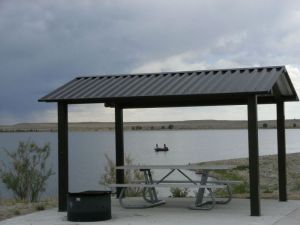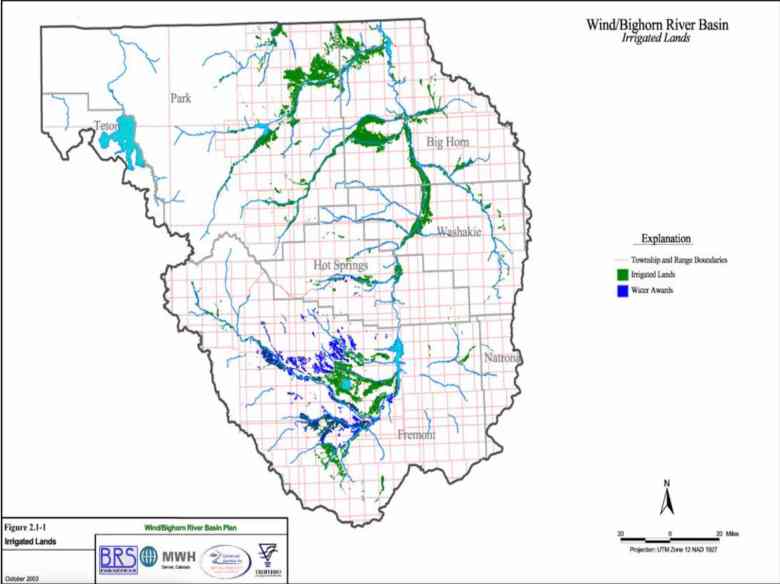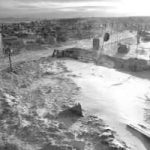This is the first in a series of 10 stories recognized by judges in the Best of the West 2020 journalism competition. The other nine stories are linked at the bottom of this story — Ed.
Millions of gallons of tainted water carrying thousands of tons of oilfield pollutants could flow into Boysen Reservoir and the Wind River each month under a proposed Wyoming Department of Environmental Quality permit, but without substantially degrading water quality, the agency says.
The permit would authorize operators of the Moneta Divide oil and gas field, which is expected to expand to 4,250 wells, to discharge 8.27 million gallons a day of “produced water” from the field. Some 25 acre feet a day could flow from the wells north of Shoshoni into Alkali and Badwater creeks that would carry the contaminants 40 miles downstream to Boysen Reservoir to be diluted.
Operators led by Aethon Energy would be permitted to discharge up to 2,161 tons a month of total dissolved solids in the flow, including more than 1,000 tons each of sodium and sulfate. Those flows would mix with purer water in the reservoir, according to the draft permit. The diluted stream would then be released into the Wind River below the Boysen Dam just above Wind River Canyon, a 12-mile reach with Wyoming’s highest water quality designation — Class 1.
“We are trying to maintain the quality of the Wind River below Boysen Dam,” said Bill DiRienzo, DEQ’s discharge program manager. Wyoming classifies the stretch between the dam and the Wedding of the Waters near Thermopolis as “outstanding water” in which “no further water quality degradation … will be allowed.”
In Boysen reservoir, a 300-foot-long area at the mouth of Badwater Creek would be a “mixing zone” where a higher concentration of pollutants would dissipate through dilution into the 20-mile long reservoir. At 5.5 miles wide, Boysen Reservoir is capable of holding 802,000 acre feet of water.
The proposal worries the Wyoming Outdoor Council, said Dan Heilig, senior conservation advocate.
“We’re not comfortable relying entirely on the information DEQ has,” he said. “We’re seeking to have consultants of our own review the materials.”
A recreation, fishing mecca.
Boysen Reservoir, the centerpiece of a 15,145 acre state park, lures anglers with walleye, sauger, perch, crappie, and ling, plus rainbow, cutthroat and brown trout. Boaters, campers and others enjoy the reserve.
 Anglers enjoy some fishing on Boysen Reservoir near a picnic table and shelter in the state park. (Wyoming State Parks)
Anglers enjoy some fishing on Boysen Reservoir near a picnic table and shelter in the state park. (Wyoming State Parks)
Below the dam the Wind River courses through a whitewater canyon on the Wind River Indian Reservation to the reservation’s northern boundary. Whitewater rafting and trout fishing are hallmarks of this free-flowing reach.
Water emerged as the public’s top priority for the BLM when the federal agency sought public input on what it should study — a process called scoping — when first considering the Moneta Divide expansion in 2012. Of 426 comments received during scoping by the BLM, 56 singled out water, followed closely by air quality.
“It’s a very popular recreation area for residents of Fremont County and surrounding communities,” Heilig said. “Young children swim in it every day in the summer. There’s boating … fishing.”
The permit would allow the discharge of up to 1,072 tons a month of sulfate and 1,426 tons a month of sodium, among other pollutants. “It’s hard to imagine this amount of pollutants will not have a significant impact on the resources and people who use Boysen for its recreational opportunities,” Heilig said.
Below the Wind River Canyon, the river — known as the Bighorn River downstream of the reservation boundary and the Wedding of the Waters — serves nine major canals and ditches. They irrigate 70,575 acres of crop and range land, according to wyomingdigest.com calculations based on state water documents. The network also waters lawns, gardens and a golf course and provides municipal water to the town of Basin
The DEQ is seeking comments by April 17 on the proposed permit, but Heilig said the 30-days provided is not enough. One reason, he said, was a “modeling report,” prepared by Aethon consultants and supporting the proposed permit, which runs 637 pages. The permit application itself is 113 pages.
DiRienzo agreed the proposal is complex. “It’s an extremely technical document,” he said of one Aethon submission. “They had four or five PhDs working on that.”
Heilig said WOC is hoping to do “an independent, objective and thorough review.” But, “we simply don’t have that time now,” and likely will seek a deadline extension.
Expansion of an older field
Ongoing oil and gas drilling operations in the area discharge approximately 50,000 barrels or some 2 million gallons per day, DiRienzo said. The existing Neptune Water Treatment Facility, which removes enough pollutants from the produced water to allow its release, would have to be expanded to handle additional flows.
“They don’t have the capacity to produce and discharge that amount of water,” proposed in the draft permit, he said. Future discharges from the field could reach 8.27 million gallons a day under the permit.
The Neptune facility employs reverse osmosis — essentially water pushed through a filter under pressure — among other methods to reduce pollutants, he said. Aethon’s application says future pollutants would be reduced with “heater treated, gravity separation, emulsion breaking chemicals, and/or skim ponds and tanks.”
 The proposed Moneta Divide oil and gas field proposed by Atheon Energy and Burlington Resources Oil and Gas Company LP would cover 265,000 acres. The area lies mostly in Fremont County but includes part of neighboring Natrona County as well. This map shows two proposed water discharge pipelines in blue that are no longer part of the plan, and a proposed gas pipeline in green. (BLM)
The proposed Moneta Divide oil and gas field proposed by Atheon Energy and Burlington Resources Oil and Gas Company LP would cover 265,000 acres. The area lies mostly in Fremont County but includes part of neighboring Natrona County as well. This map shows two proposed water discharge pipelines in blue that are no longer part of the plan, and a proposed gas pipeline in green. (BLM)
Drilling for oil and gas produces tainted water out of the ground that registers between 6,500 and 7,500 parts per million of total dissolved solids, DiRienzo said. “They will reduce that after treatment and blending … down to levels you see in the draft permit.”
Most people will say “Oh my God, that looks like a lot,” he said of the weights proposed for discharge. “It’s not really.”
The question DEQ must answer is “how much mass could be added into that [water] system and be lost in the normal background.” DiRienzo said. To answer that, Aethon, its consultants and the DEQ asked “How much salt is there right now?”
Compared to that background, the proposed discharges, “are small fractions,” he said. “They would be lost in the normal background fluctuation. That would happen through mixing in Boysen.”
The permit would allow 15 “outfall” locations where water would flow into ephemeral creek beds. Today the field only uses four, he said.
In the Boysen Reservoir mixing zone, pollutants would affect aquatic life after exposures longer than seven days, he said. Anglers shouldn’t worry, because fish won’t be tainted according to DEQ and Aethon’s analysis.
“If [a fish] is in [the mixing zone] for its entire life, it’s safe,” he said.
The designation of the Wind River as Class 1 and Boysen Reservoir as Class 2 waters means they can’t be degraded beyond a certain point. That’s compared to the water quality that existed before their classification. In this case, the Frenchie Draw gas field, a precursor to Moneta Divide, existed in the mid 1960s. The waters were not protected — and hence the baseline water quality measures were not established — until 1979.
New pollutants will be measured against those baselines, DiRienzo said. For example, the draft permit recognizes an average of 9 milligrams a liter of chloride in the Wind River today. The anti-degradation target is 12 milligrams a liter and the permit would allow a maximum of 16 milligrams.
“We would not expect more than 12,” DiRienzo said.
DEQ spokesman Keith Guille explained it another way. “With the limits that were set for this draft permit we wanted to ensure they do not impact further the Wind River as well as Boysen,” he said. “That’s what’s important. You will not see that impact.”
BLM set to authorize oil, gas field
The U.S. Bureau of Land Management is completing a draft environmental impact statement on the proposed 4,250-well Moneta Divide oil and gas field that would produce the tainted flows. The 265,000-acre field proposed by Atheon Energy and Burlington Resources Oil and Gas Company LP lies mostly in Fremont County but includes part of neighboring Natrona County as well. The actual Moneta hydrological divide separates the Wind/Bighorn basin from the Powder/Tongue drainage.
The area has been a target of development since the 1960s, Kristin Yannone, the BLM’s environmental and planning coordinator in the Lander Field Office, wrote in an email. “Some of the deepest productive gas wells on [the] continental U.S. are in the Madden Deep Unit, in Moneta,” she wrote.
There has been ongoing drilling at Moneta under an interim development plan. “We have always been willing to authorize a continuing level of development,” she said. It allows the BLM to approve a maximum amount of surface disturbance based on what has historically been the case over the previous decade.
 Water from Boysen Reservoir, lower center of the map, runs north to irrigate lands, seen in green, in Hot Springs, Washakie and Big Horn Counties. (Wyoming Water Development Office)
Water from Boysen Reservoir, lower center of the map, runs north to irrigate lands, seen in green, in Hot Springs, Washakie and Big Horn Counties. (Wyoming Water Development Office)
“The level of development has been low,” Yannone said. In the last five years “Aethon has not come within 50 percent of these caps.”
About five years ago the BLM zoned the Moneta Divide field as a Designated Development Area where other resources would take a back seat. Fully 360,000 acres north of Shoshoni were so earmarked by the BLM as part of the Lander Resource Management Plan, Yannone wrote. “This development emphasize was a balance to the almost 50 percent of the Lander planning area that the 2014 Plan identified as closed to oil and gas leasing or no-surface occupancy leasing,” her email reads.
In a DDA, “development is facilitated, primarily through efficiencies in processing of applications,” she wrote. In such areas, the BLM expedites developers’ requests to limit restrictions protecting most wildlife. There is a “slightly lower” standard for reclamation, and visual resources are secondary, she wrote.
As originally proposed by Encana, which owned most of the field before selling to Aethon, the expanded development would see 4,100 wells drilled on 3,076 pads. That plan, now being revised, called for disturbing or degrading more than 28,000 acres, almost 11,000 acres of it permanently.
Aethon and Burlington may have a smaller footprint than that proposed under the Encana plan, Yannone said in an interview. “Aethon’s approach is to emphasize a lot more directional drilling,” she said.
That modern drilling technique allows operators to cluster several wells at one surface site. “Surface disturbance is reduced under directional drilling,” she said. While Aethon has drilled up to eight wells from a single surface site, the draft environmental impact statement will estimate surface disturbance based on an average of four wells per pad, she said.
The BLM will consider several alternatives to disposing produced water. When proposed by Encana, operators would have piped the discharged water to Boysen. Aethon would let it flow 40 miles down the ephemeral Alkali and Badwater creeks.
Alkali is a waterway that barely flows. “For most of the year [produced water is] the only flow in Alkali creek,” DiRienzo said. “There might be a little bit of a base flow in the spring.”
The BLM’s role is to ensure that whatever happens with a DEQ permit “it does not cause degradation.” Yannone said. Several options remain in the mix.
“On one alternative, Aethon would discharge more water on the surface than others,” she said. “Under all alternatives, we assume the operator will meet requirements of a [DEQ] discharge permit.”
Because Aethon has invested significantly in formulating the plan to discharge the water on the surface 40 miles from Boysen, “it’s reasonable to assume that’s what they would like to do,” she said.
Wyofile did not receive response to a request for comment from an Aethon representative.
Another big document coming
Release of the oil and gas field draft EIS document could be a month away, BLM officials said. The draft EIS will reflect recent changes made to BLM conservation rules for greater sage grouse. Those were finalized March 15 and reduce federal protection of greater sage grouse and requirements to replace destroyed habitat.
Support wyomingdigest.com reporting with a tax-deductible donation
“I was instructed to hold the draft EIS to make sure everything we said [agreed] with the Record of Decision released Friday,” March 15, Yannone said. “I have incorporated those changes.”
When the draft EIS comes out – perhaps within a month — it should have a 90-day comment period.
Below are links to the other nine stories in the series recognized by judges in the Best of the West 2020 journalism competition.
Residents fret about oilfield dumping plan for Bighorn River
Residents win comment extension on oilfield pollution dump
BLM offers draft for Moneta: font of revenue, pollutants
Boysen, Moneta plan draws sharp divide between counties
Analysts hit plan to dump oilfield pollutants into Wind River
EPA: Oilfield pollution may significantly degrade Wind River
EPA: ‘Significant environmental impact’ in BLm oilfield plan
Groups: Current Moneta oilfield discharges already violate law
State eyes downgrade of oilfield creeks’ protection
The post Permit eyes tons of oilfield pollutants for Boysen, Wind River appeared first on wyomingdigest.com.







